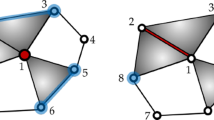Abstract
We study the persistent homology of an Erdős–Rényi random clique complex filtration on n vertices. Here, each edge e appears independently at a uniform random time \(p_e \in [0,1]\), and the persistence of a cycle \(\sigma \) is defined as \(p_2(\sigma ) / p_1(\sigma )\), where \(p_1(\sigma )\) and \(p_2(\sigma )\) are the birth and death times of \(\sigma \). We show that if \(k \ge 1\) is fixed, then with high probability the maximal persistence of a k-cycle is of order \(n^{1/k(k+1)}\).


Similar content being viewed by others
References
Alon, N., Spencer, J.H.: The Probabilistic Method, 4th edn. Wiley, Hoboken (2016)
Bauer, U.: Ripser: efficient computation of Vietoris-Rips persistence barcodes. J. Appl. Comput. Topol. 5(3), 391–423 (2021)
Bobrowski, O., Kahle, M.: Topology of random geometric complexes: a survey. J. Appl. Comput. Topol. 1(3–4), 331–364 (2018)
Bobrowski, O., Kahle, M., Skraba, P.: Maximally persistent cycles in random geometric complexes. Ann. Appl. Probab. 27(4), 2032–2060 (2017)
Bobrowski, O., Skraba, P.: On the Universality of Random Persistence Diagrams. (submitted), arXiv:2207.03926, (2022)
Brennan, M., Bresler, G., Nagaraj, D.: Phase transitions for detecting latent geometry in random graphs. Probab. Theory Related Fields 178(3–4), 1215–1289 (2020)
Bubeck, S., Ding, J., Eldan, R., Rácz, M.Z.: Testing for high-dimensional geometry in random graphs. Random Struct. Algorithms 49(3), 503–532 (2016)
Cohen-Steiner, D., Edelsbrunner, H., Harer, J.: Stability of persistence diagrams. Discrete Comput. Geom. 37(1), 103–120 (2007)
Edelsbrunner, H., Letscher, D., Zomorodian, A.: Topological persistence and simplification. Discrete Comput. Geom. 28(4), 511–533 (2002)
Giusti, C., Pastalkova, E., Curto, C., Itskov, V.: Clique topology reveals intrinsic geometric structure in neural correlations. Proc. Natl. Acad. Sci. 112(44), 13455–13460 (2015)
Hoffman, C., Kahle, M., Paquette, E.: Spectral gaps of random graphs and applications. Int. Math. Res. Not. IMRN 2021(11), 8353–8404 (2021)
Kahle, M.: Topology of random clique complexes. Discrete Math. 309(6), 1658–1671 (2009)
Kahle, M.: Sharp vanishing thresholds for cohomology of random flag complexes. Ann. Math. 179(3), 1085–1107 (2014)
Kahle, M.: Random simplicial complexes. In Handbook of Discrete and Computational Geometry, pp. 581–603. Chapman and Hall/CRC, (2017)
Linial, N., Meshulam, R.: Homological connectivity of random 2-complexes. Combinatorica 26(4), 475–487 (2006)
Malen, G.: Collapsibility of random clique complexes. arXiv:1903.05055, (2019)
Newman, A.: One-sided sharp thresholds for homology of random flag complexes. arXiv:2108.04299, (2021)
Paquette, E., Werf, A.V.: Random geometric graphs and the spherical Wishart matrix. arXiv:2110.10785, (2021)
Acknowledgements
We thank both anonymous referees for their corrections and helpful comments. MK also thanks Greg Malen and Andrew Newman for several helpful conversations.
Funding
Both authors gratefully acknowledge the support of NSF-DMS #2005630.
Author information
Authors and Affiliations
Corresponding author
Ethics declarations
Conflict of interest
The authors have no competing interests to declare that are relevant to the content of this article.
Additional information
Publisher's Note
Springer Nature remains neutral with regard to jurisdictional claims in published maps and institutional affiliations.
Rights and permissions
Springer Nature or its licensor (e.g. a society or other partner) holds exclusive rights to this article under a publishing agreement with the author(s) or other rightsholder(s); author self-archiving of the accepted manuscript version of this article is solely governed by the terms of such publishing agreement and applicable law.
About this article
Cite this article
Ababneh, A., Kahle, M. Maximal persistence in random clique complexes. J Appl. and Comput. Topology (2023). https://doi.org/10.1007/s41468-023-00131-y
Received:
Revised:
Accepted:
Published:
DOI: https://doi.org/10.1007/s41468-023-00131-y



